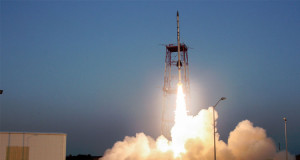 Recently NASA launched a Black Brant IX sounding rocket which has beem assembled using 3-D printing and ultra-lightweight carbon nanotube (CNT) composite materials to create its wire sheathing, heat and radiation shields.
Recently NASA launched a Black Brant IX sounding rocket which has beem assembled using 3-D printing and ultra-lightweight carbon nanotube (CNT) composite materials to create its wire sheathing, heat and radiation shields.
NASA noted the manufacturer (Orbital ATK) used a new “near net shape” manufacturing method that allows the cylinder of the rocket to be formed and stiffened with internal structures in one step, rather than with dozens or hundreds of welds. According to Space Flight Insider, using hundreds of welds can be costly, make the rocket heavier and introduce potential failure points. NASA believes this new methodology could potentially mitigate those risks for other products as well.
“These technologies will bring significant value to a wide range of aerospace and defense products—including launch vehicles, spacecraft, aircraft and marine vehicles,” NASA wrote in an October 2 online preview of the launch. They add the technologies lead to an “estimated 40-60 percent mass savings, increased technical performance and reduced maintenance over traditional materials.”
Part of what makes this particular mission unique is the type of rocket used to test composite materials. “The flight also provides an opportunity to test new technologies being developed for space missions and science conducted using sounding rockets,” said Cathy Hesh, technology manager in the Sounding Rocket Program Office at Wallops Flight Facility.
The online preview adds that eight students from the NASA Internships, Fellowships, and Scholarships program working at Langley were instrumental in supporting the construction of the experimental materials. The interns performed the structural analysis of the flight cylinder, evaluated the microstructure and properties and did a cost-benefit analysis of the integrally stiffened cylinder (ISC) process. They did much of the 3-D printing for the Orbital ATK tests and acted as the liaisons between Orbital ATK and Wallops.



